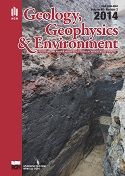Corrosion stratifications on glass jewellery excavated beneath the market square in Kraków, Poland
DOI:
https://doi.org/10.7494/geol.2014.39.2.233Keywords:
induced corrosion, glass corrosion, metal corrosion, glass jewellery, glass sensorAbstract
Glass has been one of the materials selected for its decorative purposes since early mankind. Its production was complex and varied all around the world, considering the sources of local materials used for its production as well technological knowledge about the manufacturing process. The aim of this work is to put some light on glass jewelry unearthed during the archeological excavations at the Main Market Square in Kraków, and to increase the importance of a stratifications investigation of ancient subjects by induced corrosion, using glass sensors.
The collected data helps to determinate the definitive condition of a historical object. This data will also help to establish the chemical nature of the corrosion products and the altered glass and metal surfaces. Moreover, the ring presented in this work can be considered to be from a small group of fine medieval jewelry corresponding to the upper class of the population, such as the nobility or wealthy merchants. Such individuals dealt with the exchange of goods with foreign countries. Because of a very limited amount of analytical material, only nondestructive analysis: scanning electron microscopy (SEM) and energy dispersive X-ray spectroscopy (EDXS), X-ray diffraction (XRD), X-ray fluorescence spectrometry (XRF), glass sensors were applied. The glass and metal have been tested separately.
Downloads
References
Andrusieczko A., 1972. Technologia szkła: praca zbiorowa. Arkady, Warszawa.
Biezborodow M.A., 1956. Driewnierusskije stiekła i ognieupornyje izdielija. Kratkije Soobszczenija IIMK, 62, 79.
Dekówna M., 1980. Szkło w Europie wczesnośredniowiecznej. Zakład Narodowy im. Ossolińskich, Wrocław.
Eggert G., 2010. Corroding glass, corroding metals: survey of joint metal-glass corrosion products on historic objects. Corrosion Engineering, Science and Technology, 45, 5, 414-419.
Fuxi G., Brill R.H. & Shouyun T., 2009. Ancient Glass Research along the Silk Road. World Scientific Publishing Company.
Gimeno D., Garcia-Valles M., Fernandez-Turiel J.L., Bazzocchi F., Aulinas M., Puges M., Tarozzi C., Riccardi M.P., Basso E., Fortina C., Mendera M. & Messiga B., 2008. From Siena to Barcelona: Deciphering colour recipes of Na-rich Mediterranean stained glass windows at the XII-XIV century transition. Journal of Cultural Heritage, 9, 10-15.
Greiner-Wronowa E., 2005. Metoda sensorów szklanych w analizie przemian chemicznych korozji szkła. Świat Szkła, 5, 64-67.
Greiner-Wronowa E., 2010. Sensory szklane-metoda wczesnego monitorowania mikroklimatu w muzeum. Szkło i Ceramika, 3, 12-17.
Greiner-Wronowa E., Pusoska A. & Piasecka J., 2007. Biały nalot na obiektach szklanych w gablotach muzealnych. Szkło i Ceramika, 1, 26-31.
Greiner-Wronowa E., Zabiegaj D. & Piccardo P., 2013. Glass-metal objects from archaeological excavation: corrosion study. Applied Physics A, 113, 999-1008.
Jokubonis C., Wobrauschek P., Zamini S., Karwowski M., Trnka G. & Stadler P., 2003. Results of quantitative analysis of Celtic glass artefacts by energy dispersive X-ray fluorescence spectroscopy. Spectrochimica Ada Par B, 58, 627-633.
Kubiak WW. & Gołaś J. (red.), 2005. Instrumentalne metody analizy chemicznej. Wydawnictwo Naukowe „Akapit", Kraków.
Lierke R., 2009. Die nicht-geblasenen antiken Glasgefasse: ihre Herstellung von den Anfangen bis zu den Luxusglasern der Romer. Deutsche Glastechnische Gesellschaft.
Olczak J., 1959. Proizwodstwo stieklanych pierstniej na slowanskoj territorii w srednije wieka. Sowietskaja Archeologija, 3, 81-83.
Olczak J., Jasiewiczowa E., 1963. Szklarstwo wczesnośredniowiecznego Wolina. Muzeum Pomorza Zachodniego, Szczecin.
Pfaender H.G., 1996. Schott Guide to Glass. 2nd ed. Chapman & Hall, London.
Shelby J.E., 2005. Introduction to Glass Science and Technology. 2nd ed. The Royal Society of Chemistry, London.
Stawiarska T., 1984. Szkła z okresu wpływów rzymskich z północnej Polski. Studium technologiczne. Zakład Narodowy im. Ossolińskich, Wrocław.
Sulimirski T., 1943. Faience beads in the Polish Bronze Age. Man, 139, 124-125.
Theophilus, 1880. Teofila kapłana i zakonnika o sztukach rozmaitych ksiąg troje [księga 2: O pierścieniach}. Akademia Umiejętności, Kraków.
Vilarigues M., Redol P., Machado A., Rodrigues P.A., Alves L.C. & Silva R.C., 2010. Corrosion of 15th and early 16th century stained glass from monastery of Batalha studied with external ion beam. Materials Characterization, 22, 40-52.
WAWEL 1000-2000, Biuletyn Informacyjny Biura Prasowego Kraków 2000, 32, 2000, [on-line:] http://www.kra-kow2000.pl/biuletyn/biuletyn_32.html.
Zabiegaj D., 2010. Zmiany korozyjne biżuterii szklanej z prac archeologicznych pod Rynkiem Głównym w Krakowie. AGH, Kraków [M.Sc. thesis].
Downloads
Published
Issue
Section
License
Authors have full copyright and property rights to their work. Their copyrights to store the work, duplicate it in printing (as well as in the form of a digital CD recording), to make it available in the digital form, on the Internet and putting into circulation multiplied copies of the work worldwide are unlimited.
The content of the journal is freely available according to the Creative Commons License Attribution 4.0 International (CC BY 4.0)










